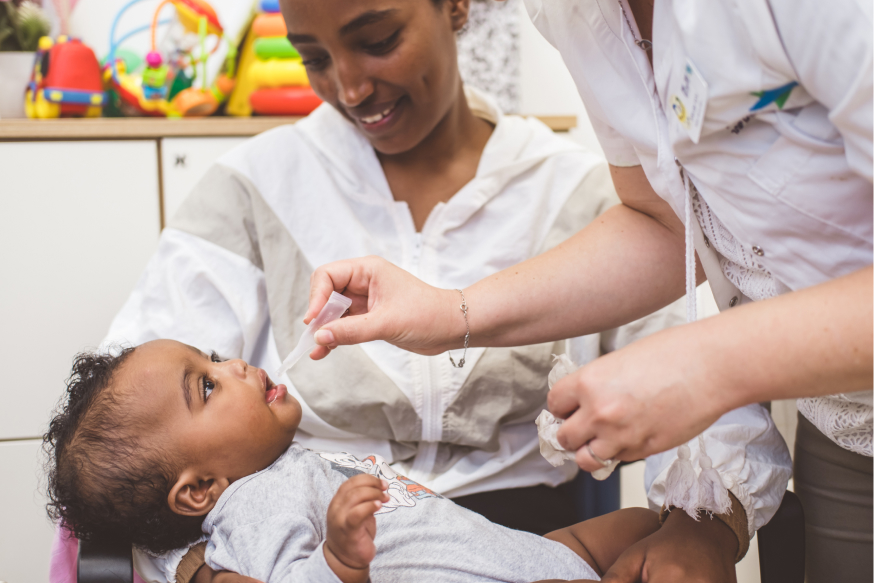Measles Outbreak: Get Vaccinated Soon
Measles Outbreak: Get Vaccinated Soon
We recommend that residents of communities with an active measles outbreak, visitors to these communities, and anyone traveling abroad:
-
Have infants aged 6–11 months receive a measles vaccine shot earlier than scheduled. This shot is in addition to the two routine shots given at 12 months of age and in 1st grade.
-
Have adults and children over 12 months old who have had one shot receive a second shot earlier than scheduled.
RSV VACCINE
RSV VACCINE
RSV can cause serious breathing problems in premature babies and young infants.
Starting September 2025, the RSV vaccine will be given to all newborns in the hospital as part of the immunization schedule.
Babies born between February 19 and August 31, 2025 can get the vaccine at family care centers ('tipat halav'), along with regular shots.
Immunization Schedule
Let's get to know the schedule:

Hepatitis B is a prevalent liver disease in infants, often asymptomatic. Hepatitis B vaccination reduces infection by 90% and saves lives.

The RSV virus causes respiratory illnesses. Most babies will get the RSV vaccine in the hospital right after they’re born. Babies born between April 1 and July 31 will be vaccinated at the family health center, along with their regular shots. Babies at higher risk will receive an extra dose during the second RSV season of their life.

Hepatitis B is a prevalent liver disease in infants, often asymptomatic. Hepatitis B vaccination reduces infection by 90% and saves lives.

It is important that babies and children get the 5 in 1 vaccine, which protects them from 5 diseases that can cause serious damage and even death: tetanus, diphtheria, pertussis, polio (inactivated vaccine) and haemophiles influenza B. Administered at 2 months, 4 months, 6 months, and 12 months of age. In the 2nd grade, diphtheria, tetanus, pertussis and polio (inactivated vaccine) vaccines are given. In the 8th grade, diphtheria, tetanus, and pertussis vaccines are given. Read more:

The rotavirus causes vomiting, severe diarrhea, and fluid loss, which can be particularly dangerous for infants aged six months to two years.

This vaccine protects against the pneumococcus bacteria, which cause meningitis, blood infections (sepsis), pneumonia, and ear infections.

It is important that babies and children get the 5 in 1 vaccine, which protects them from 5 diseases that can cause serious damage and even death: tetanus, diphtheria, pertussis, polio (inactivated vaccine) and haemophiles influenza B. Administered at 2 months, 4 months, 6 months, and 12 months of age. In the 2nd grade, diphtheria, tetanus, pertussis and polio (inactivated vaccine) vaccines are given. In the 8th grade, diphtheria, tetanus, and pertussis vaccines are given. Read more:

The rotavirus causes vomiting, severe diarrhea, and fluid loss, which can be particularly dangerous for infants aged six months to two years.

This vaccine protects against the pneumococcus bacteria, which cause meningitis, blood infections (sepsis), pneumonia, and ear infections.

It is important that babies and children get the 5 in 1 vaccine, which protects them from 5 diseases that can cause serious damage and even death: tetanus, diphtheria, pertussis, polio (inactivated vaccine) and haemophiles influenza B. Administered at 2 months, 4 months, 6 months, and 12 months of age. In the 2nd grade, diphtheria, tetanus, pertussis and polio (inactivated vaccine) vaccines are given. In the 8th grade, diphtheria, tetanus, and pertussis vaccines are given. Read more:

The rotavirus causes vomiting, severe diarrhea, and fluid loss, which can be particularly dangerous for infants aged six months to two years.

After completing this vaccination, the child will be protected against hepatitis B. This is the third dose in the hepatitis B vaccine series.

It is important that babies and children get the 5 in 1 vaccine, which protects them from 5 diseases that can cause serious damage and even death: tetanus, diphtheria, pertussis, polio (inactivated vaccine) and haemophiles influenza B. Administered at 2 months, 4 months, 6 months, and 12 months of age. In the 2nd grade, diphtheria, tetanus, pertussis and polio (inactivated vaccine) vaccines are given. In the 8th grade, diphtheria, tetanus, and pertussis vaccines are given.

This vaccine protects against the pneumococcus bacteria, which cause meningitis, blood infections (sepsis), pneumonia, and ear infections.

The 4 in 1 vaccine protects from four diseases: measles, mumps, rubella and chickenpox. Read more:

Hepatitis A is an inflammation caused by a virus. In severe and rare cases, it can lead to acute liver failure and necessitate a liver transplant.

Hepatitis A is an inflammation caused by a virus. In severe and rare cases, it can lead to acute liver failure and necessitate a liver transplant.

The 4 in 1 vaccine protects from four diseases: measles, mumps, rubella and chickenpox. Read more:

In second grade, students are given a vaccine that protects from 4 diseases that can cause serious damage and even death: diphtheria, tetanus, pertussis and polio. Read more:

It is recommended to get the vaccine every year before the winter, ideally in September-November.

It is recommended to get the vaccine every year before the winter, ideally in September-November.

It is recommended to get the vaccine every year before the winter, ideally in September-November.

In the 8th grade, students are given a vaccine for 3 diseases that can cause serious damage and even death: diphtheria, tetanus, and pertussis. Read more:

The human papillomavirus (HPV) vaccine protects against the virus strains that can cause cervical cancer and other severe illnesses. Its effectiveness is higher when administered at a young age, emphasizing the importance of timely vaccination.

















